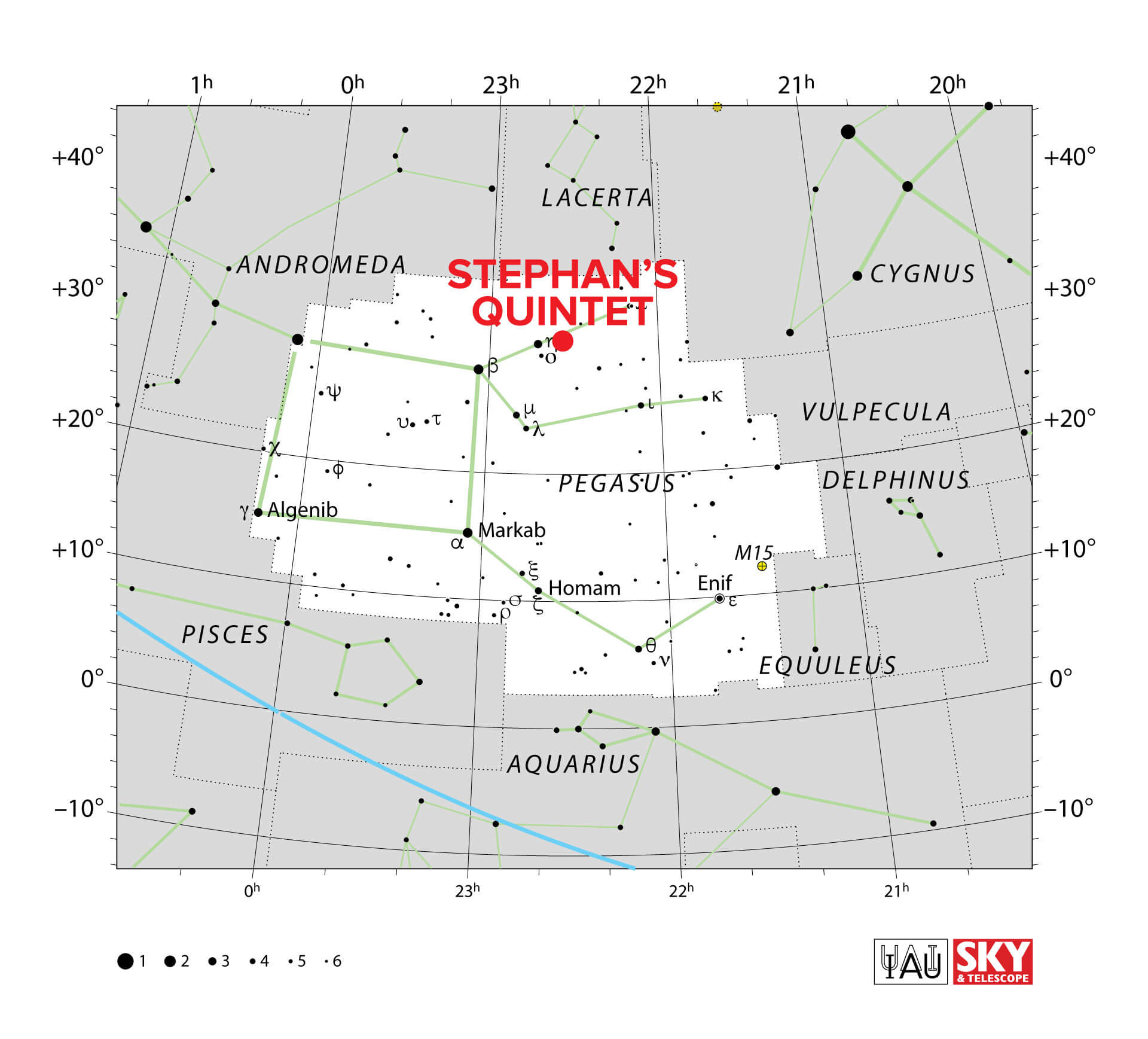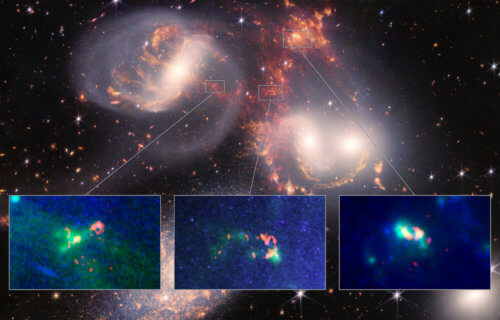CHARLOTTESVILLE, Va. — The James Webb Space Telescope (JWST) is at it again, revealing another marvel in deep space. Along with the Atacama Large Millimeter/submillimeter Array (ALMA), astronomers used the high-powered telescopes to spot a violent collision between galaxies in Stephan’s Quintet.
Stephan’s Quintet is a group of five galaxies — NGC 7317, NGC 7318a, NGC 7318b, NGC 7319, and NGC 7320 — which sit roughly 270 million light years from Earth in the constellation Pegasus. The stunning collection provides scientists with a perfect lab to study galaxy collisions, according to researchers at the National Radio Astronomy Observatory.
Now, however, astronomers say an “intruder galaxy” is crashing into the quintet. The collision is helping scientists understand how the shockwaves and turbulence influence gas in the intergalactic medium. ALMA and JWST discovered that a sonic boom several times larger than the entire Milky Way galaxy has triggered what researchers are calling a “recycling plant” for warm and cold hydrogen gas.
However, there’s also a mystery taking place at the heart of this collision in space. Typically, galaxy collisions lead to a burst of star formations, but that’s not what’s happening with Stephan’s Quintet. Instead, the violent crash is taking place in the intergalactic medium — an area with little to no star formations. This is also providing scientists with an unobstructed view of what’s really happening!

Credit: IAU/Sky & Telescope
JWST and ALMA have captured galaxy NGC 7318b intruding into the larger group of galaxies at a speed of approximately 800 kilometers per second. For context, it would take just eight minutes to go from the Earth to the Moon at that speed.
“As this intruder crashes into the group, it is colliding with an old gas streamer that likely was caused by a previous interaction between two of the other galaxies, and is causing a giant shockwave to form,” says Philip Appleton, an astronomer and senior scientist at Caltech’s IPAC, and lead investigator on the project, in a media release.
“As the shockwave passes through this clumpy streamer, it is creating a highly turbulent, or unsteady, cooling layer, and it’s in the regions affected by this violent activity that we’re seeing unexpected structures and the recycling of molecular hydrogen gas. This is important because molecular hydrogen forms the raw material that may ultimately form stars, so understanding its fate will tell us more about the evolution of Stephan’s Quintet and galaxies in general.”
What’s going on in Stephan’s Quintet?
ALMA’s Band 6 (1.3mm wavelength) receiver helping scientists zoom in to see three key regions and get clear pictures of how the hydrogen gas is moving for the first time ever.
“The power of ALMA is obvious in these observations, providing astronomers new insights and better understanding of these previously unknown processes,” says Joe Pesce, Program Officer for ALMA at the U.S. National Science Foundation (NSF).
At the center of the main shock wave (Field 6), scientists found a cloud of cold molecules breaking apart and stretching out into a long tail of warmer molecular hydrogen. The hydrogen is repeatedly recycled through these same phases.
“What we’re seeing is the disintegration of a giant cloud of cold molecules in super-hot gas, and interestingly, the gas doesn’t survive the shock, it just cycles through warm and cold phases,” says Appleton. “We don’t yet fully understand these cycles, but we know the gas is being recycled because the length of the tail is longer than the time it takes for the clouds it is made from to be destroyed.”
This isn’t the only strange thing happening in Stephan’s Quintet after the galactic shockwave. In a region called “Field 5,” there are two more cold gas clouds connected by a stream of warm hydrogen. Study authors say one of these clouds resembles a “high-speed bullet” cutting through the larger, thread-like filament of spread-out gas.
“A molecular cloud piercing through intergalactic gas, and leaving havoc in its wake, may be rare and not yet fully understood,” adds Bjorn Emonts, an astronomer at NRAO and a co-investigator on the project. “But our data show that we have taken the next step in understanding the shocking behavior and turbulent life-cycle of molecular gas clouds in Stephan’s Quintet.”
Meanwhile in “Field 4,” scientists found what they call the most “normal” turbulent environment in the stellar environment. The quieter area allowed hydrogen gas to collapse into a disk of stars.
“In field 4, it is likely that pre-existing large clouds of dense gas have become unstable because of the shock, and have collapsed to form new stars as we expect,” says Pierre Guillard, a researcher at the Institut d’Astrophysique de Paris and a co-investigator on the project.
“The shock wave in the intergalactic medium of Stephan’s Quintet has formed as much cold molecular gas as we have in our own Milky Way, and yet, it forms stars at a much slower rate than expected. Understanding why this material is sterile is a real challenge for theorists. Additional work is needed to understand the role of high levels of turbulence and efficient mixing between the cold and hot gas.”
Scientists still don’t know why these clouds survived
“These clouds should have been destroyed by the large-scale shockwave moving through the group, but weren’t. And we wanted to know, and still want to know, how did they survive?” Appleton says.
To get to the bottom of this, ALMA’s first observations took place in late 2011 and the JWST captured its first images earlier this year.
“These new observations have given us some answers, but ultimately showed us just how much we don’t yet know,” Appleton concludes. “While we now have a better understanding of the gas structures and the role of turbulence in creating and sustaining them, future spectroscopic observations will trace the motions of the gas through the doppler effect, tell us how fast the warm gas is moving, allow us to measure the temperature of the warm gas, and see how the gas is being cooled or warmed by the shockwaves. Essentially, we’ve got one side of the story. Now it’s time to get the other.”
Researchers presented their new observations in a press conference at the 241st meeting of the American Astronomical Society (AAS) in Seattle, Washington.
Zooming in on Turbulence in Stephen’s Quintet from NRAO Outreach on Vimeo.

Imodium would fix that.